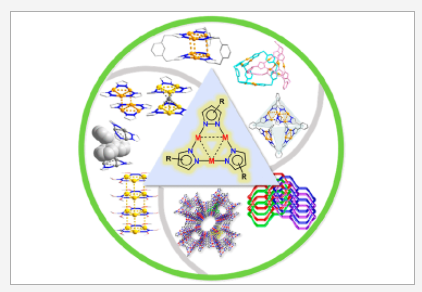
Ji Zheng, Zhou Lu, Kun Wu, Guo-Hong Ning,* and Dan Li*

ABSTRACT: Among the d10 coinage metal complexes, cyclic trinuclear complexes (CTCs) or trinuclear metallocycles with intratrimer metal−metal interactions are fascinating and important metal−organic or organometallic π-acids/bases. Each CTC of characteristic planar or near-planar trimetal nine-membered rings consists of Au(I)/Ag(I)/Cu(I) cations that linearly coordinate with N and/or C atoms in ditopic anionic bridging ligands. Since the first discovery of Au(I) CTC in the 1970s, research of CTCs has involved several fundamental areas, including noncovalent and metallophilic interaction, excimer/exciplex, acid−base chemistry, metalloaromaticity, supramolecular assemblies, and host/guest chemistry. These allow CTCs to be embraced in a wide range of innovative potential applications that include chemical sensing, semiconducting, gas and liquid adsorption/separation, catalysis, full-color display, and solid-state lighting. This review aims to provide a historic and comprehensive summary on CTCs and their extension to higher nuclearity complexes and coordination polymers from the perspectives of synthesis, structure, theoretical insight, and potential applications.




